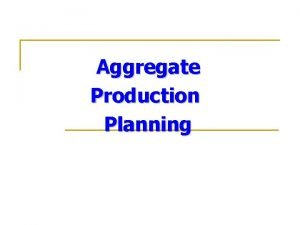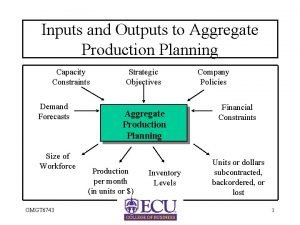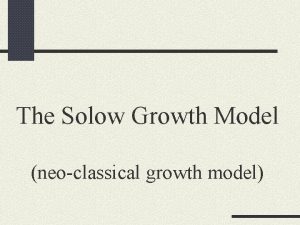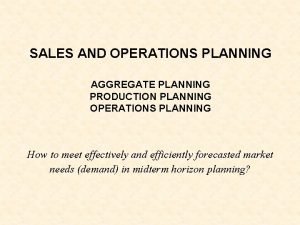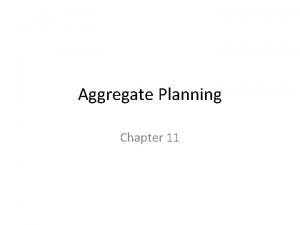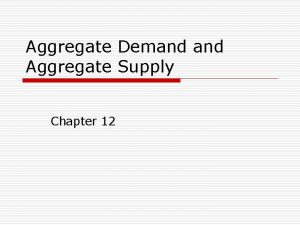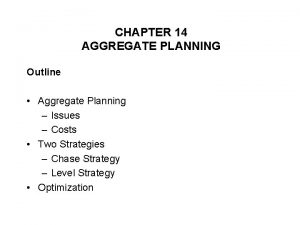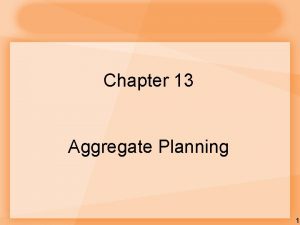Aggregate Production Planning Chapter 7 Aggregate Production Planning















- Slides: 15

(Aggregate) Production Planning Chapter 7

(Aggregate) Production Planning l Process for determining aggregate levels of production (i. e. , at product line/group level) l Production plan links strategic goals to production and is coordinated with sales objectives, resource availabilities, and financial budgets l New term—Sales and Operations Planning

Role of Production Planning

Production-Planning Process l l Begin with updated sales forecast covering the planning periods (usually one year or more) Desired changes (increases or decreases) to inventory and backlogs are factored in Periodic reviews and updates are conducted. See forecast (Figure 7. 3) and cumulative forecast/production plan (Figure 7. 4)

Production Planning Formulas l Make-to-Stock Finished goods inventory = previous inventory + production - demand forecast l Make-to-order Backlog = customer orders + previous backlog production l Assemble-to-order Semi-finished goods inventory = previous inventory + production - demand forecast

Production Planning Strategy l Chase strategy—production output is changed to chase sales. Incurs costs of changing the workforce level, hours worked, and subcontracting l Level strategy—production is at a uniform rate, with inventory buildups and depletions. Incurs inventory holding and backorder costs l Mixed (hybrid) strategy

Trade-offs l Aggregate output is converted into resource requirements by using a planning factor (e. g. , converting aggregate sales dollars into labor requirements—see Figure 7. 5) l Basic trade-offs: inventory accumulations, hiring and firing, under-time and overtime, and alternative capacity options such as subcontracting

Production Planning Methods l Trial-and-error method l Optimization methods l Heuristic Methods

Evaluating Alternatives l Establish cost data that relate to the alternative production-planning methods (See Figure 7. 6) l Determine starting conditions (on-hand inventory, beginning workforce level) l Example—Figure 7. 7

Management Obligations l Top management: force the resolution of trade-offs between functional areas l Functional roles (manufacturing, sales, engineering, finance, human resources): • Hit the plan. • Communicate when something will prevent hitting the plan, as well as provide continual feedback on performance versus the plan.

Potential Difficulties with Production Planning l Large number of products and product families l Complexity of planning models/methods l Unavailability of useable data l Lack of understanding and direction from top management l Lack of cooperation from other functions

Concluding Principles (VBW, p. 302) l l l The production plan is not a forecast; it must be a managerial statement of desired output. The production plan should be a part of the game planning process so it will be in complete agreement with other functional plans (sales plan, budget, etc. ). The trade-offs to frame the production plan must be made prior to final approval of the plan.

Concluding Principles l l l There must be top-management involvement in the game planning process, which should be directly related to strategic planning. The MPC system should be used to perform routine activities and provide routine data, so management can address non-routine tasks. The MPC system should be used to facilitate what-if analyses at the production-planning level.

Concluding Principles l l l Reviews of performance against production plans and sales forecasts are needed to prompt re-planning when necessary. The production plan should provide the MPS parameters. The sum of the detailed MPS must always equal the production plan. The production plan should tie the company’s strategic activities directly through the MPS to the execution modules.

Homework Assignments l Problems 7. 2, and 7. 3 l Due Tuesday, Sept. 17 l We will do problem 7. 1 in class. Problems 7. 2 and 7. 3 are variations using the same framework.
 Shift in sras curve
Shift in sras curve Aggregate planning strategies
Aggregate planning strategies Mrp outputs
Mrp outputs Pengertian produksi multimedia
Pengertian produksi multimedia Aggregate planning is capacity planning for:
Aggregate planning is capacity planning for: Aggregate planning is capacity planning for
Aggregate planning is capacity planning for Aggregate planning is capacity planning for
Aggregate planning is capacity planning for How to calculate aggregate demand
How to calculate aggregate demand Tableau cannot mix aggregate and non aggregate
Tableau cannot mix aggregate and non aggregate Unit 3 aggregate demand and aggregate supply
Unit 3 aggregate demand and aggregate supply Unit 3 aggregate demand aggregate supply and fiscal policy
Unit 3 aggregate demand aggregate supply and fiscal policy Unit 3 aggregate demand aggregate supply and fiscal policy
Unit 3 aggregate demand aggregate supply and fiscal policy Solow's model
Solow's model Capital deepening examples
Capital deepening examples Sample of production plan
Sample of production plan The strategy
The strategy

